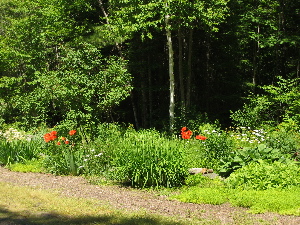DOGWOOD SAWFLY
The last two weeks have been a challenge for my Red Osier Dogwood. All of a sudden this tree began to look absolutely terrible. The leaves were being eaten and the tree was looking pretty sad. On closer observation I could see there were TONS of little ashen, grayish-white caterpillars. There were as many as 10 little caterpillars on each leaf, curled into a little ball. UGLY and obviously being totally destructive to the tree. In two days I watched as the tree was totally decimated. Oh, oh! This was NOT a good thing.
I looked up caterpillars on the internet and could find NOTHING that looked like these little characters. I was flummoxed. Off I went to Agway, which was on my way to the UNH Extension Office. I thought MAYBE they would have a clue...or maybe it was some new introduction to NH gardens. The folks at Agway were as confused as I. I was all set to buy some BT with which to spray them but held off. I thought it would be better, in case there was another treatment that would work better. I surely didn't want to double treat anything. So, the BT remained on the shelf.
Off I went to the Extension office with my little jar of caterpillars. None of the "experts" were there, so she took the jar and disappeared to take some photographs which were sent to the NH Entomologist, Alan Eaton. She requested a quick reply. By the next morning, I had my answer.
The reason I couldn't find this caterpillar was that it was NOT a caterpillar! Instead, it was a sawfly, a dogwood sawfly in fact. It was good I didn't get the BT, because it would have been totally useless and ineffective.
Here is the response I recieved from Alan Eaton.
"The insects are dogwood sawflies. They are not caterpillars, even though they look similar. The distinction is important, because a common, effective biological control used for caterpillars (Bacillus thuringiensis spray) will not affect these insects. Various chemical insecticides registered for backyard ornamental plants will work on these, including Sevin, and products containing permethrin and other pyrethroids.
... "When fully grown (soon, by the looks of the photo) they look for rotting wood in which to burrow and pupate. Sometimes if the affected bush is touching a building, they can burrow into composition board or other soft-ish material, as they look for a pupation site."
There you have it! Here is a link to have a look at what these critters look like.
By the way, we sprayed the tree with Sevin, and by the next morning, all the sawflies were dead on the ground around the dogwood. Whew!





0 Comments:
Post a Comment
<< Home